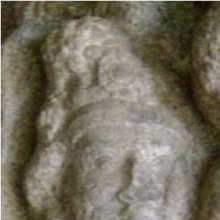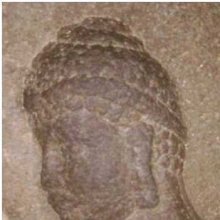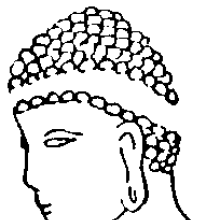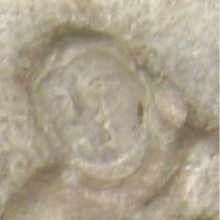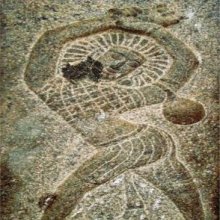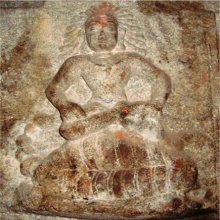Hair: 3 definitions
Introduction:
Hair means something in Hinduism, Sanskrit, the history of ancient India. If you want to know the exact meaning, history, etymology or English translation of this term then check out the descriptions on this page. Add your comment or reference to a book if you want to contribute to this summary article.
Images (photo gallery)
(+174 more images available)
In Hinduism
Purana and Itihasa (epic history)
Source: Shodhganga: Elements of Art and Architecture in the Trtiyakhanda of the VisnudharmottarapuranaHair (and other body parts) were traditionally coloured by professional artists, as part of the “sixty four kinds of Art”, according to the Kamasutra of Vatsyayana.—Cf. the Sanskrit Daśanavasanāṅgarāga.—Indian tradition, basically includes sixty four Art forms are acknowledged. The history of Indian Art covers approximately five thousand years which presents a rich and almost continuous record. The references of sixty four kinds of Kala (कला, kalā) are found in the Bhagavatapurana, Shaiva-Tantras, Kamasutra of Vatsyayana etc.

The Purana (पुराण, purāṇas) refers to Sanskrit literature preserving ancient India’s vast cultural history, including historical legends, religious ceremonies, various arts and sciences. The eighteen mahapuranas total over 400,000 shlokas (metrical couplets) and date to at least several centuries BCE.
Yoga (school of philosophy)
Source: ORA: Amanaska (king of all yogas): A Critical Edition and Annotated Translation by Jason BirchHair is denoted by the Sanskrit term Keśa, according to the Amanaska Yoga treatise dealing with meditation, absorption, yogic powers and liberation.—Accordingly, as Īśvara says to Vāmadeva: “[...] Putting on ochre garments, carrying a skull, plucking out clumps of hair (keśa-āvalī), maintaining non-vedic religious observances, ashes, ascetic clothing and matted locks, behaving as if mad, [the ascetic practice of] nakedness, [studying] the Vedas, Tantras and so on and the meeting [of learned people] for [reciting] poetry in the assembly: All [this] is exertion for the sake of filling one's stomach and is not the cause of the highest good. [...]”.

Yoga is originally considered a branch of Hindu philosophy (astika), but both ancient and modern Yoga combine the physical, mental and spiritual. Yoga teaches various physical techniques also known as āsanas (postures), used for various purposes (eg., meditation, contemplation, relaxation).
India history and geography
Source: Singhi Jain Series: Ratnaprabha-suri’s Kuvalayamala-katha (history)Hair was given special care, as part of the tasks performed to beautify the Sleeping chamber (of young ladies) in Ancient India, as depicted in the Kathās (narrative poems) such as Uddyotanasūri in his 8th-century Kuvalayamālā (a Prakrit Campū, similar to Kāvya poetry).—The Kuvalayamala (779 A.D.) is full of cultural material which gains in value because of the firm date of its composition. [...] Page 83.3-9: Here is the description of the house or the sleeping chambers of young ladies which were beautified for the reception of their husbands. The select items in this list are as follows: [e.g., dressing the hair and pouring the jugs;] [...]

The history of India traces the identification of countries, villages, towns and other regions of India, as well as mythology, zoology, royal dynasties, rulers, tribes, local festivities and traditions and regional languages. Ancient India enjoyed religious freedom and encourages the path of Dharma, a concept common to Buddhism, Hinduism, and Jainism.
See also (Relevant definitions)
Starts with (+68): Hair bentgrass, Hair cap moss, Hair moss, Hair-like sedge, Haira, Hairamba, Hairami, Hairan, Hairana, Hairanagata, Hairanagollu, Hairani, Hairanu, Hairanvati, Hairanya, Hairanyabaheya, Hairanyagarbha, Hairanyaka, Hairanyanabha, Hairanyastupa.
Ends with (+29): Aleutian maidenhair, Black maidenhair, California maidenhair, Chair, Chopada khair, Delta maidenhair, Dhavi-khair, Durgandh-khair, Golden maidenhair, Goya-khair, Grey hair, Gul-e-khair, Gulkhair, Jar-khair, Kempukhair, Khair, Laal-khair, Laalkhair, Lal-khair, Lalkhair.
Full-text (+4375): Kesa, Roman, Palita, Veni, Loma, Pulaka, Pulakita, Kesava, Murdhaja, Keshakeshi, Lomasha, Kantakita, Shirasija, Keshanta, Shrivatsa, Shikha, Dhammilla, Keshapasha, Keshabandha, Sakesha.
Relevant text
Search found 384 books and stories containing Hair; (plurals include: Hairs). You can also click to the full overview containing English textual excerpts. Below are direct links for the most relevant articles:
Pallava period (Social and Cultural History) (by S. Krishnamurthy)
Coiffure of Men < [Chapter 4 - Material Culture of the People]
Coiffure of Children < [Chapter 4 - Material Culture of the People]
Coiffure of Women < [Chapter 4 - Material Culture of the People]
The Markandeya Purana (Study) (by Chandamita Bhattacharya)
Hair Style < [Chapter 2]
Use of Cosmetics, Perfumes, Incense, etc. < [Chapter 2]
Divisions of Āśrama (c): Vānaprastha < [Chapter 2]
Sankhayana-grihya-sutra (by Hermann Oldenberg)
The Jataka tales [English], Volume 1-6 (by Robert Chalmers)
Jataka 9: Makhādeva-jātaka < [Book I - Ekanipāta]
Jataka 411: Susīma-jātaka < [Volume 3]
Jataka 501: Rohanta-Miga-jātaka < [Volume 4]
The Skanda Purana (by G. V. Tagare)
Chapter 37 - The Characteristics of Women < [Section 1 - Pūrvārdha]
Chapter 136 - Greatness of Lomaśeśvara (Lomaśa-īśvara) < [Section 1 - Prabhāsa-kṣetra-māhātmya]
Chapter 88 - Greatness of Aṃbāvṛddhā < [Section 1 - Tīrtha-māhātmya]
The Garuda Purana (by Manmatha Nath Dutt)
Chapter CXCIX - Various other medicinal Recipes < [Dhanvantari Samhita]
Chapter LXIII - A brief discourse on the auspicious and inauspicious marks on the persons of males < [Agastya Samhita]
Chapter CLXV - The Nidanam of Bodily parasites < [Dhanvantari Samhita]
Related products
(+241 more products available)
